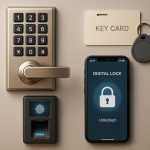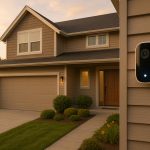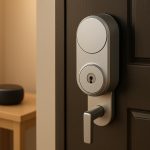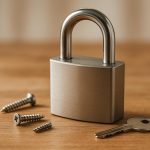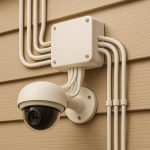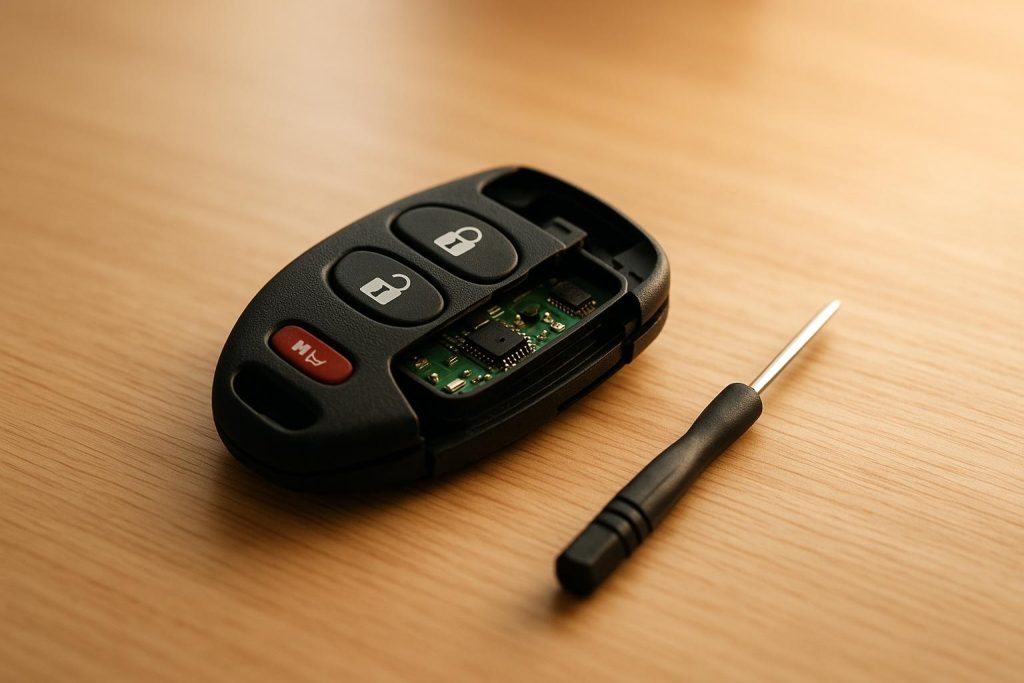Keyless entry systems make life easier by replacing physical keys with keypads, fobs, or apps. But when they fail, it can be frustrating. Common problems include dead batteries, programming errors, or physical damage. Here’s how to fix them:
- Inspect and clean: Remove dirt or grime from keypads and fobs.
- Replace batteries: Dead batteries are often the culprit. Use the correct type and orientation.
- Reset or reprogram: Follow your system’s manual for resetting codes or reprogramming fobs.
- Check wiring and power: Look for loose connections, blown fuses, or corroded wires.
- Consult the manual: Use manufacturer instructions for error codes and troubleshooting steps.
If these steps don’t work, call a professional locksmith, like Sherlock’s Locksmith in Pittsburgh, PA. They specialize in repairs, programming, and security upgrades for residential, automotive, and commercial systems. Regular maintenance, like cleaning and replacing batteries, can prevent many issues.
How To Reset Key FOB After Changing Battery (Resync a Key Fob)
Keyless Entry System Components
Understanding the components of a keyless entry system can make troubleshooting much easier. Each part has a specific job, and knowing how they work together helps you quickly identify and address any issues.
Key Components and Their Functions
- Keypads: These are the main interface for code-based entry systems. Designed to withstand harsh conditions, keypads are typically weatherproof and feature backlit buttons for better visibility at night. They connect to the control module using low-voltage wiring and consume very little power when idle.
- Key fobs: These handheld devices communicate wirelessly with the system’s receiver. Inside each fob is a circuit board, antenna, and battery. When a button is pressed, the fob sends a unique radio frequency signal, usually operating at 315 MHz or 433 MHz in the U.S. The typical range is 50 to 100 feet, though obstacles and environmental factors can affect this.
- Control modules: Often referred to as the "brain" of the system, the control module processes signals from keypads and fobs, stores access codes, and operates the locking mechanism. It also handles functions like automatic re-locking or temporary code expiration, thanks to its built-in memory chips.
- Receivers and antennas: These components pick up signals from key fobs and pass them to the control module. The receiver is often integrated into the control module, while the antenna may be a separate wire or an internal part. Poor placement of the antenna can weaken signal reception and reduce performance.
- Wiring harnesses, power supplies, and grounding: These ensure smooth communication between all components. Damage or corrosion in these areas can lead to system failures. Power sources vary by application – vehicle batteries for cars, household circuits for residential systems, or backup batteries for emergencies. Many systems include a battery backup to keep them running during power outages.
- Actuators and strike plates: These are the physical parts of the locking mechanism. Electric strikes, magnetic locks, or motorized deadbolts receive signals from the control module to lock or unlock. Proper alignment of these parts is critical; even slight misalignment can cause malfunctions.
Using System-Specific References
Each keyless entry system is unique, and manufacturer documentation is your best resource for troubleshooting. Manuals typically include wiring diagrams, programming instructions, error codes, and information on compatible replacement parts.
Programming steps can differ greatly depending on the brand and model. Some systems require specific keypad sequences, while others rely on specialized tools or smartphone apps. Manuals also provide default codes and factory reset procedures, which can be crucial during troubleshooting.
Using the wrong batteries, fuses, or components can lead to further problems or even damage the system. Manufacturer documentation also includes warranty details and technical support contacts for additional help if standard troubleshooting doesn’t resolve the issue.
Modern systems often come with diagnostic features or error codes to pinpoint specific problems. Your manual will explain how to access these diagnostics and interpret the results, making repairs quicker and more precise.
Common Keyless Entry Problems
Keyless entry systems, while convenient, aren’t immune to issues. Problems often arise from malfunctioning key fobs or keypads, usually caused by physical wear, damage, programming glitches, or aging components. Let’s break down the most common challenges these systems face.
Keypad or Key Fob Not Responding
Key fobs can wear out over time, especially with frequent use. Physical damage – like being dropped or even chewed – can harm the internal components, rendering them ineffective. Additionally, programming errors can interfere with how the key fob communicates with the control module, leading to unresponsiveness.
Step-by-Step Troubleshooting Guide
When your keyless entry system starts acting up, a step-by-step approach can help you pinpoint and resolve the issue. Most problems are tied to basic maintenance, like dead batteries or dirt buildup, so it’s best to start with the simplest fixes before diving into more technical solutions. Begin by carefully inspecting the keypad and key fob for any visible problems.
Inspect and Clean Keypad or Key Fob
Keypad Inspection: Check for dirt, grime, or debris that might be affecting button responsiveness. Sticky or stiff buttons are often caused by buildup, which can interfere with proper function. Use a soft cloth with a mild cleaner to wipe down the keypad and clear debris from between the buttons. For stubborn grime, carefully clean around jammed buttons using appropriate tools. If buttons remain sticky, a small amount of non-greasy lubricant can help. Avoid harsh chemicals that could damage the keypad.
Key Fob Inspection: Handle your key fob gently while checking for wear or physical damage that might affect the buttons. If the buttons are worn or damaged, you may need to open the fob to clean the contacts or replace the button membrane. To protect your fob from future damage, consider using a silicone or rubber case.
Additional Checks: Inspect for loose connections, unresponsive buttons, or anything obstructing the sensors that could weaken the signal. If your system includes a fingerprint scanner, clean it with a dry cloth to maintain its accuracy.
Replace Batteries and Test Again
Dead or weak batteries are one of the most common reasons for keyless entry issues. Identify the correct battery type by checking the system’s manual or examining the existing battery for markings like CR2032, CR2025, or CR1632. These coin-cell batteries generally last 1–2 years, depending on usage.
For Key Fobs: Locate the battery compartment, which may have a small screw, sliding panel, or release tab. Open the compartment, remove the old battery, and note its orientation before inserting the new one. The positive (+) side usually faces up, but confirm this with the markings inside the compartment.
For Keypad Locks: The battery compartment is typically on the interior side of the door. Open the cover and replace all batteries at once, even if only one seems dead. Mixing old and new batteries can cause performance issues.
After replacing the batteries, test all functions immediately. If the system doesn’t respond, give it a few minutes to initialize.
Reset or Reprogram the System
If cleaning and new batteries don’t fix the problem, resetting or reprogramming might be necessary. Start with a basic reset by removing the batteries for 10–15 seconds, then reinstalling them to clear temporary glitches.
For Code Issues: Reprogram the access codes. Most systems have a master reset process that involves pressing specific button combinations while the door is open. Refer to your user manual for the exact sequence, as it varies by brand.
Key Fob Reprogramming: Place the system in programming mode and press the fob buttons in the required sequence. Some systems may also require turning a key in the lock while pressing the fob buttons. Be prepared, as the programming window is usually only 10–20 seconds.
If you’ve replaced batteries in multiple devices, you may need to reprogram all key fobs and reset user codes. Complete power interruption can sometimes cause the system to lose its programming.
Check Wiring, Fuses, and Power Sources
If the system still isn’t working, the issue could be electrical. Start with the fuse – if your keyless entry system connects to a home electrical system or vehicle fuse box, look for a blown fuse (the metal strip inside will be broken) and replace it with one of the same amperage.
Test Power Connections: Use a multimeter set to DC voltage to confirm the system is getting the correct voltage (typically 12V for automotive systems or as specified in the manual). Check both power and ground connections.
Inspect Wiring: Look for damaged, corroded, or loose wires. Frayed wires, green corrosion on metal connections, or wires disconnected from terminals are common culprits. In vehicles, road salt and moisture often contribute to corrosion.
Control Module Issues: If your system has a control module, it could fail due to moisture, extreme temperatures, or electrical surges. Signs of a failing module include erratic operation, partial functionality, or complete failure.
When to Check the User Manual
If basic troubleshooting hasn’t worked, it’s time to consult the manufacturer’s manual. Brands like Kwikset, Schlage, and Yale have unique programming steps, reset instructions, and error codes that aren’t interchangeable.
Error Codes: Many modern systems use LED lights or beeping patterns to indicate specific problems, such as low battery warnings or programming errors. Your manual will explain what these signals mean.
Brand-Specific Procedures: Advanced functions like master code resets, user management, or smart home integration often require precise button sequences and timing, which vary by manufacturer.
The manual also includes warranty details and contact information for authorized service providers. If all else fails, some systems may require professional servicing or programming.
sbb-itb-643e28e
Maintenance for Keyless Entry Systems
After resolving specific issues, regular maintenance is key to keeping your keyless entry system reliable over time. Beyond immediate fixes, consistent care helps prevent problems from cropping up in the future.
Regular Battery Replacement
Don’t wait for batteries to die before replacing them. Most keyless entry systems use coin-cell batteries, and how often you need to replace them depends on how frequently the system is used. Heavy usage may require more frequent changes, while lighter use allows for longer intervals. To avoid surprises, set a schedule for battery replacements and stick to it. Low battery warnings often come when the power is almost gone, so it’s better to replace batteries proactively rather than reactively. If you have multiple key fobs, swap out all the batteries at the same time to ensure consistent performance across devices.
Cleaning and Inspection
Regular cleaning can prevent sticky buttons and poor connections caused by dirt buildup. Use a slightly damp microfiber cloth to clean keypads, avoiding harsh chemicals that could damage the device. For outdoor keypads, a soft brush or compressed air can help remove stubborn debris.
Periodic inspections are just as important. Check for signs of corrosion, frayed wires, or loose connections, especially in automotive systems where wear and tear from vibrations or weather is common. Don’t forget to examine key fobs for physical damage, like cracked cases, which might let moisture seep in and harm internal electronics. If you spot damage, replacing the protective case is often an affordable fix compared to buying a new fob altogether.
Professional Maintenance
When routine upkeep isn’t solving the problem, bringing in a professional can ensure your system stays in top shape. Certified locksmiths have the tools and expertise to diagnose issues that might not be obvious during everyday use. Regular professional inspections can catch minor problems before they escalate into major failures.
For commercial keyless entry systems that experience heavy daily use, more frequent professional checks are a smart move to maintain security and prevent lockouts. Additionally, firmware updates might be necessary to keep the system secure. Professionals can ensure these updates are done correctly, keeping user codes and key fobs synced without a hitch.
If your system shows signs of aging or recurring problems, consider scheduling a comprehensive evaluation. A professional can advise whether targeted repairs will do the trick or if a full system replacement is the better long-term option.
For expert assistance, reach out to Sherlock’s Locksmith. Based in Pittsburgh, PA, they specialize in keyless entry system maintenance. Their certified technicians handle everything from detailed inspections to programming updates and can recommend upgrades to enhance reliability and security. With 24/7 mobile service, they’re ready to address your maintenance needs whenever they arise.
When to Call a Professional Locksmith
After trying basic troubleshooting steps, it’s important to know when it’s time to bring in a professional. While many issues can be resolved on your own, certain problems require the expertise of a certified locksmith. Acting quickly can help you avoid further damage or security risks. Here are the key signs that professional help is necessary.
Signs DIY Troubleshooting May Not Work
Repeated system failures are a red flag. If your keyless entry system keeps malfunctioning despite efforts like replacing batteries, cleaning, or reprogramming, the issue may stem from internal components or complex wiring that needs specialized diagnostic tools.
Reprogramming issues that persist can signal deeper problems. If your system refuses to accept new codes or key fob programming – even after following the manufacturer’s instructions – it could mean the control module has software corruption or hardware issues. Attempting to fix it further might make things worse.
Unpredictable electrical behavior is another warning. If your keyless system works on and off, powers down randomly, or shows erratic responses, this often points to faulty wiring, loose connections, or failing control modules. These problems are best left to professionals with the right diagnostic equipment.
Physical damage should never be ignored. Cracked keypads, damaged wiring, or water-damaged control modules can compromise the system’s functionality and security. Proper assessment and replacement with compatible parts are crucial to avoid making the problem worse.
Security concerns require immediate professional attention. If your keyless entry system has been tampered with, shows signs of unauthorized access, or you suspect a breach, it’s essential to have a locksmith evaluate the situation to ensure your security isn’t further compromised.
When these issues arise, calling a professional locksmith is the safest and most effective course of action.
Sherlock’s Locksmith: Trusted Locksmith Services in Pittsburgh, PA
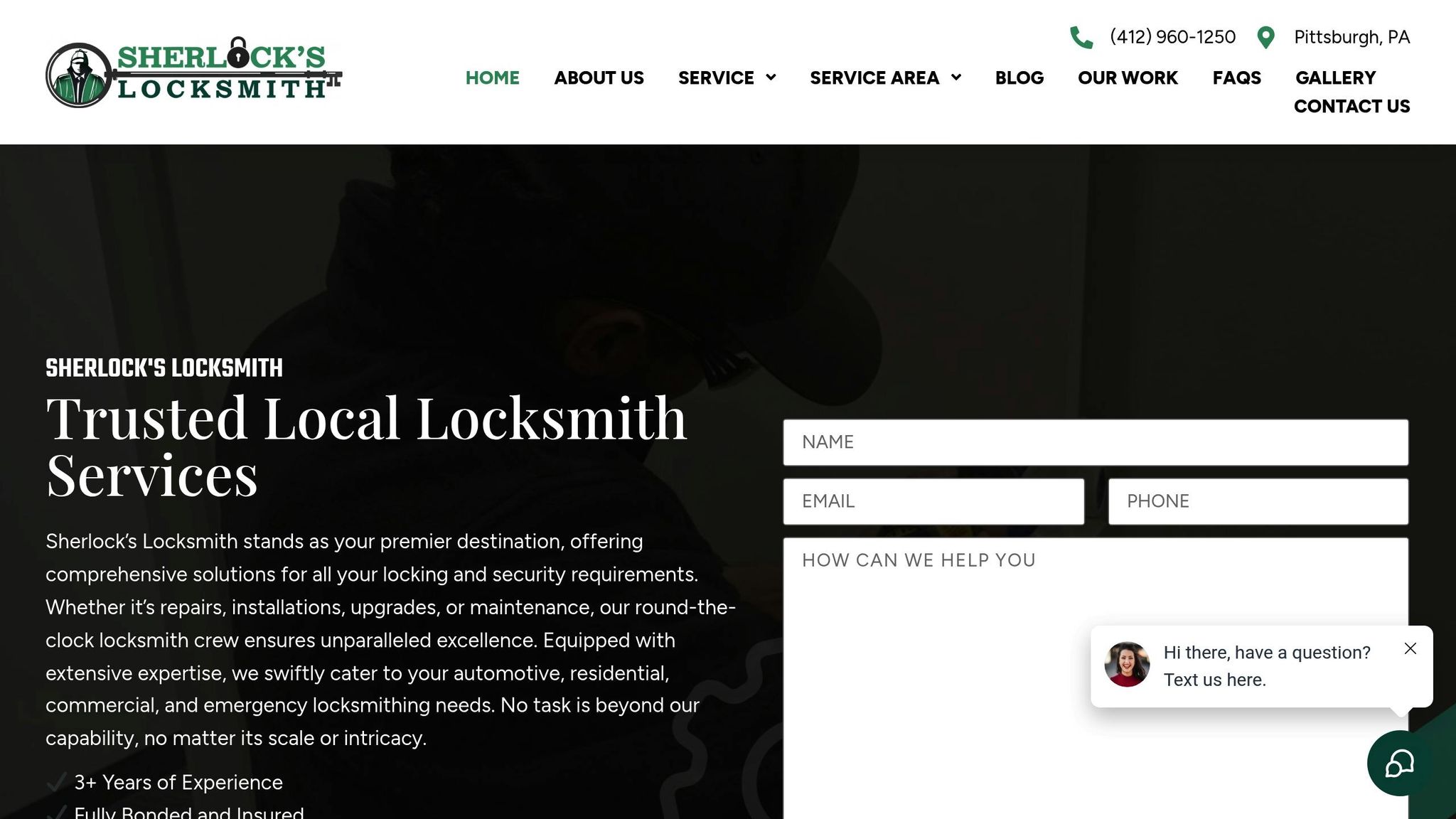
When DIY efforts fall short, Sherlock’s Locksmith is here to help. Based in Pittsburgh, PA, their team specializes in resolving keyless entry system issues with advanced tools and expertise.
Automotive keyless entry specialists at Sherlock’s Locksmith handle all makes and models, offering services like transponder programming and full system replacements. Their mobile team can diagnose and fix problems wherever you are – whether at home or stuck in a parking lot.
Residential and commercial services are also part of their expertise. From simple keypad locks to complex access control systems, Sherlock’s Locksmith can install, repair, or upgrade systems to meet your needs, whether it’s for a single-family home or a business with multiple access points.
24/7 emergency service ensures you’re never left stranded. If your keyless entry system fails at an inconvenient time, their round-the-clock team can quickly restore access. They arrive equipped to handle most repairs on-site.
Advanced security upgrades are available if your system is outdated or lacks adequate protection. Sherlock’s Locksmith can recommend and install modern systems with features like biometric access, smartphone integration, or enhanced encryption to boost your security.
What sets Sherlock’s Locksmith apart is their mobile convenience and expertise. Instead of requiring you to bring components to a shop, their technicians come fully equipped with diagnostic tools, replacement parts, and programming equipment. They not only fix the immediate issue but also provide guidance on maintaining your system for long-term reliability.
If you’ve exhausted your troubleshooting options, reaching out to Sherlock’s Locksmith ensures your keyless entry system is restored to full functionality and security. Their professional team in Pittsburgh is ready to provide expert solutions tailored to your needs.
Conclusion
When dealing with keyless entry issues, it’s essential to approach troubleshooting step by step. Start with the basics – check the batteries, clean the keypads, and try using backup keys. These simple fixes often resolve the most common problems. Routine maintenance, like replacing batteries and cleaning components, can also help you avoid many issues before they arise. However, if these efforts don’t work, it’s time to seek professional assistance.
For those moments when DIY solutions fall short, Sherlock’s Locksmith in Pittsburgh is ready to step in. Their mobile team is equipped with advanced diagnostic tools to quickly restore your keyless entry system to working order. Whether you’re dealing with an automotive fob, a residential keypad, or a commercial access system, their certified technicians have the know-how to get your security system back on track.
Remember, it’s important to know when to hand things over to the experts. If your troubleshooting efforts don’t resolve the issue, professional locksmiths can address persistent problems or hardware failures that require specialized tools and expertise. Signs like unresponsive buttons, loose connections, or other wear and tear are clear indicators that it’s time for professional help. And in urgent cases, such as lockouts, emergency locksmith services can provide fast and reliable solutions.
A dependable keyless entry system is crucial for both security and convenience. By following these troubleshooting tips and knowing when to call in the pros, you can ensure your system remains reliable and secure.
FAQs
What can I do if my keyless entry system stops working even after changing the batteries and cleaning it?
If your keyless entry system is still giving you trouble after replacing the batteries and cleaning, the next step is to inspect for any visible damage to the wiring or electronic components of the lock. Sometimes, swapping out the battery can reset the key fob’s programming, so you might need to reprogram it. Check your vehicle or device manual for detailed instructions on how to handle this.
If these fixes don’t solve the problem, the issue might be more complex – like hardware malfunctions or signal interference. In such cases, contacting a professional locksmith is a smart move. Sherlock’s Locksmith, available 24/7 in Pittsburgh, PA, offers mobile locksmith services and can help diagnose and repair keyless entry problems, getting your system back up and running without delay.
How can I figure out if my keyless entry system problem is caused by programming or hardware issues?
To figure out if your keyless entry system issue is tied to programming or hardware, start by testing how the system works. If reprogramming or resetting fixes the problem, it’s likely a programming issue. On the other hand, if the system still doesn’t respond, the problem could stem from hardware – like dead batteries, a faulty transponder chip, damaged wiring, or worn-out buttons.
Look for any visible signs of damage or anything that might interfere with the system’s performance. Checking these factors can help you pinpoint whether the issue is software-related or due to faulty hardware. If you’re unable to fix it yourself, it’s a good idea to contact a professional locksmith for help. For those in Pittsburgh, PA, Sherlock’s Locksmith provides 24/7 troubleshooting and repair services for keyless entry systems.
When should I call a locksmith for help with my keyless entry system, and what can they do to assist?
If swapping out the batteries or reprogramming your keyless entry system doesn’t do the trick, it might be time to bring in a professional locksmith. These experts are well-equipped to handle a variety of issues, from fixing electronic glitches to reprogramming key fobs and even upgrading advanced security systems.
Locksmiths are also lifesavers in emergencies – like when you’re locked out of your car or home. They provide swift and dependable access while keeping your security intact. If you’re in Pittsburgh, PA, and need 24/7 locksmith services, Sherlock’s Locksmith has certified technicians and state-of-the-art tools to tackle all your keyless entry challenges.



